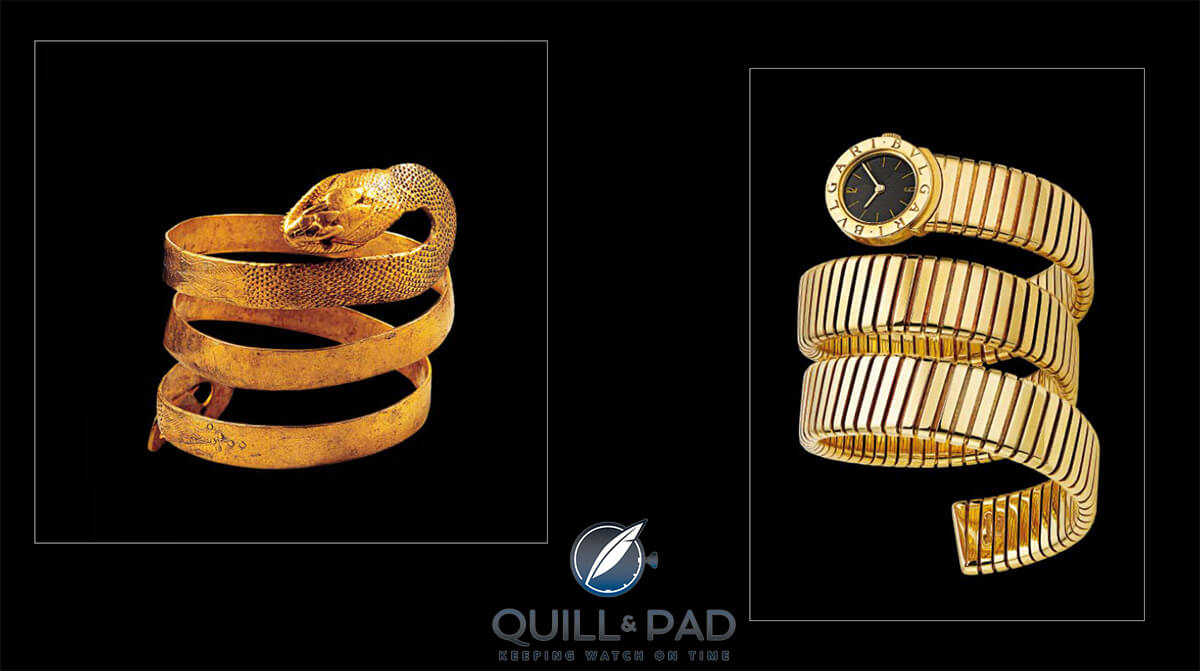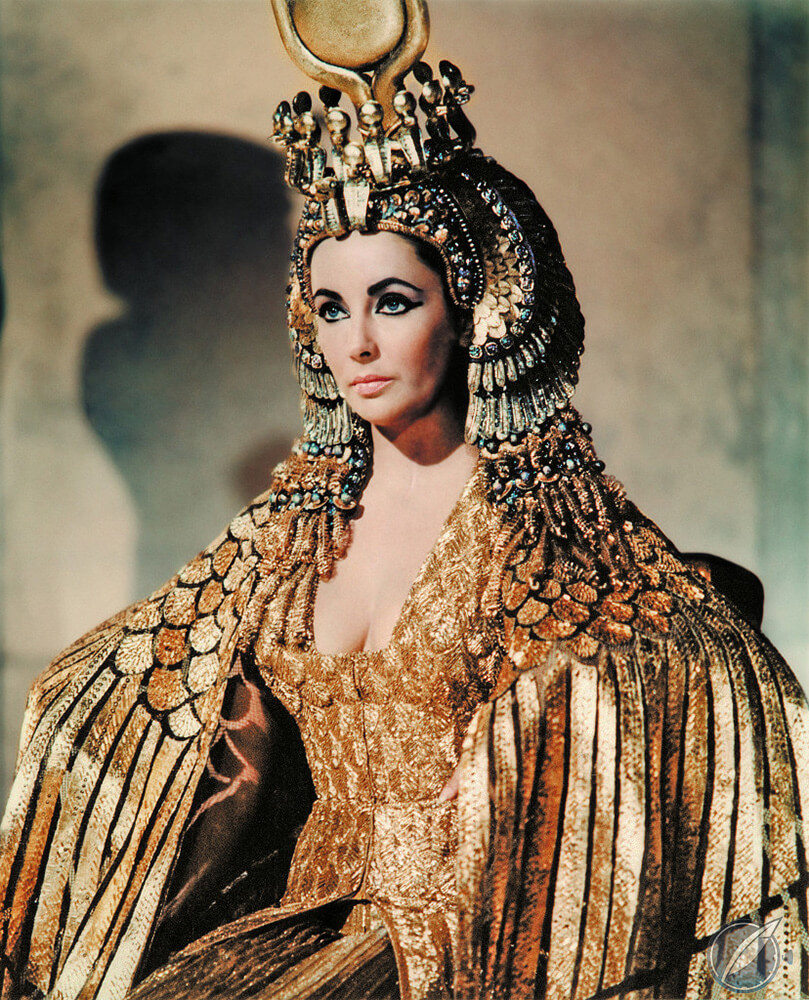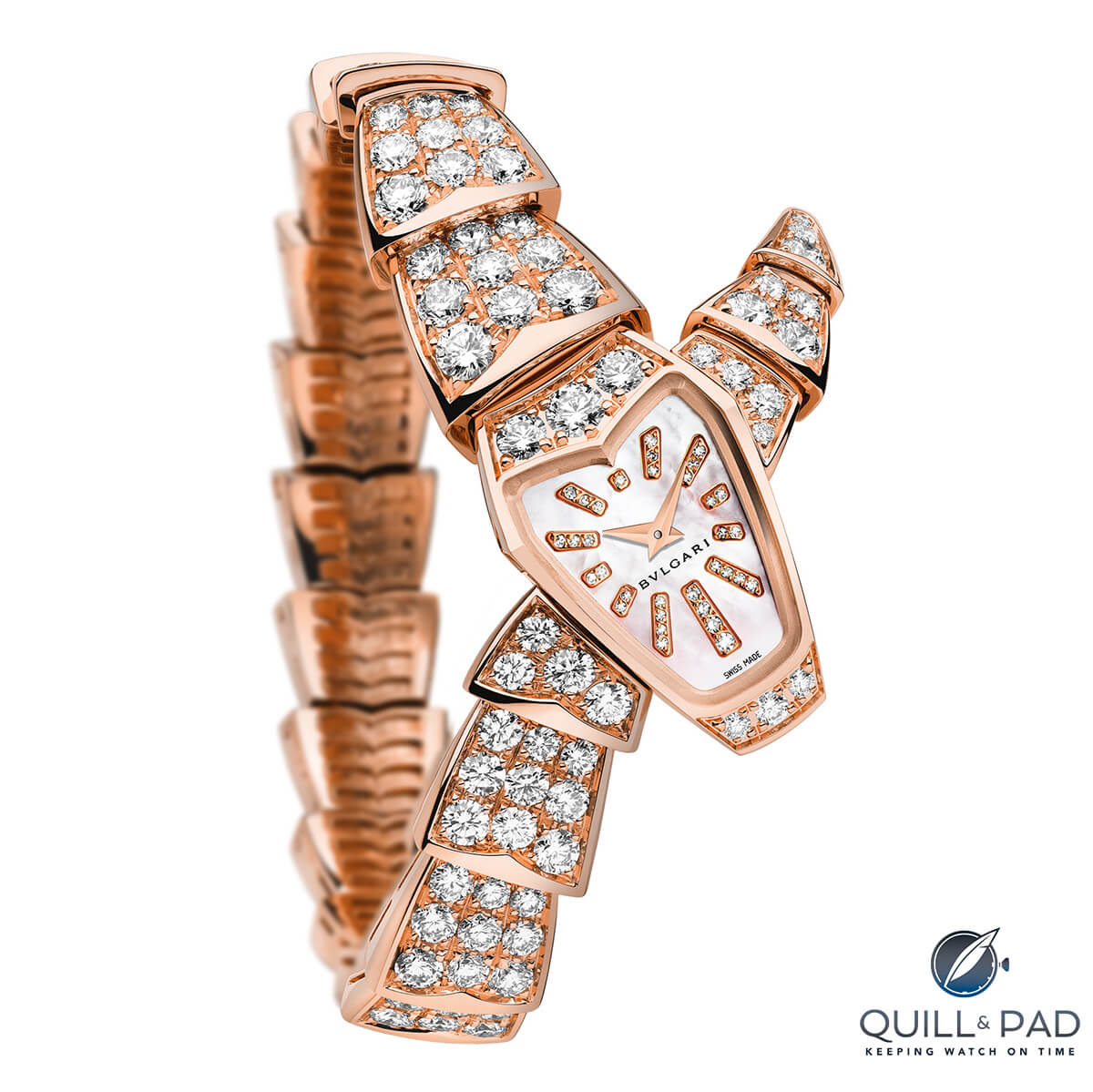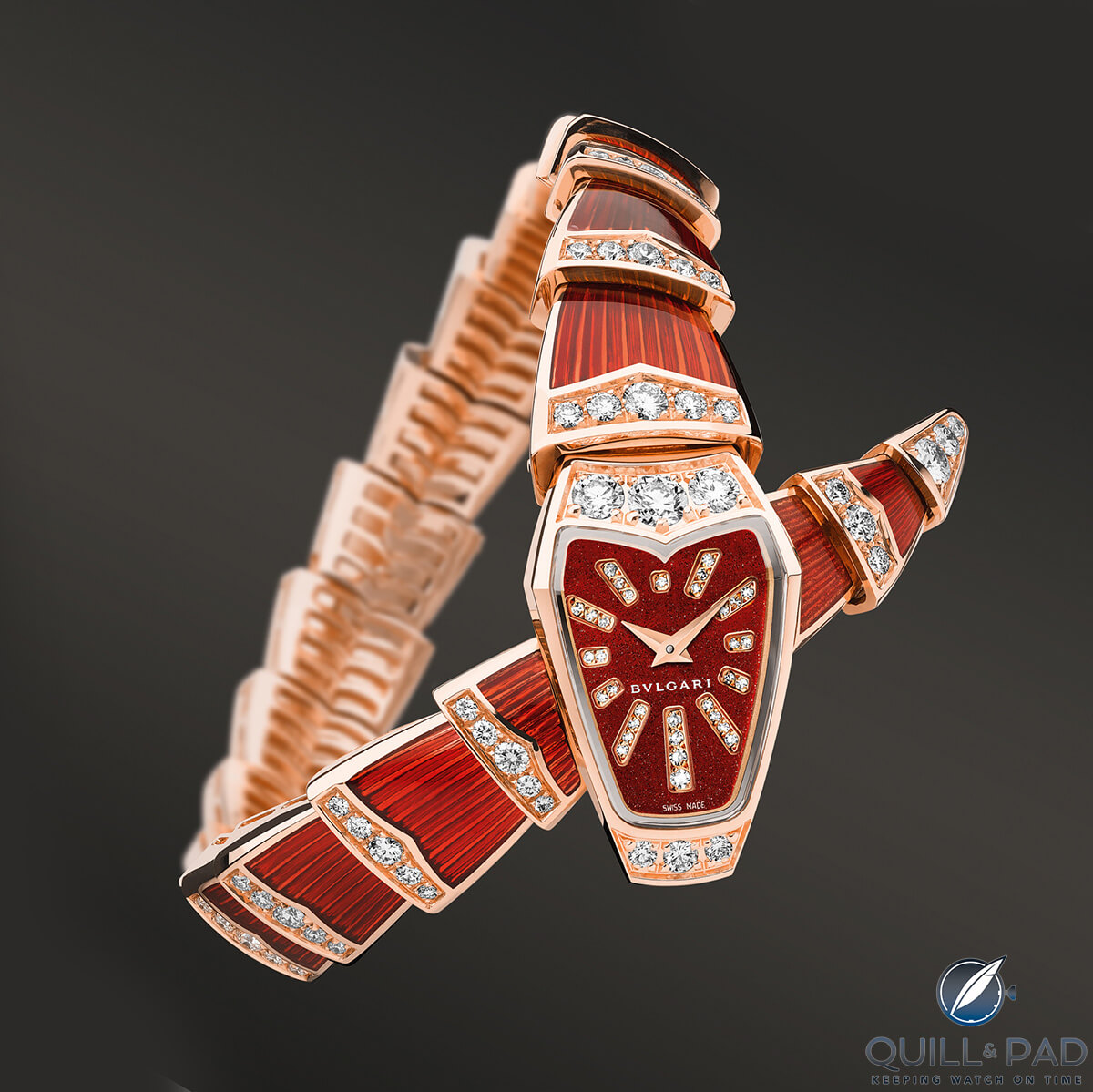by Sabrina Doerr
Bulgari was founded in 1884 by Sotirio Bulgari, a man of Greek heritage who lived in Rome (real name: Sotirios Voulgaris). These two great artistic cultures influenced Bulgari’s design, though the truly iconic snake-themed Serpenti collection perhaps benefited most from his mixed influences.
Having begun with silverware and decorative items, it wasn’t until 1905 that Bulgari decided to make jewelry. This was a good move as the brand soon became known for the luxurious quality of its pieces, and over the years many celebrities have proudly worn Bulgari.
When Sotirio died in 1932, his sons Giorgio and Constantino took over. Under their leadership, Bulgari remained successful and matured through the years with the fashions of the times.
Origins and early years
Today, Bulgari carries on with the serpent theme, which began in the 1940s. And in fact the snake has evolved into a creative symbol for the brand.
Like a snake shedding its skin, since that decade dominated by war and recovery, the Bulgari Serpenti has metamorphosed, reinventing itself. However, the basic concept remains the same.
Bulgari’s Greco-Roman heritage sees many of the brand’s designs – especially jewelry designs – based in history, reinterpreting the past but with an added modern twist to make them more interesting.
This is how the idea for the Serpenti collection came about: in both Greek and Roman mythology, snakes represented positive characteristics such as rebirth, healing, protection, strength, eternity, and seductiveness thanks to the elegance of the creatures’ soft, winding bodies.
The symbolic importance of the snake is powerful. Just think of Asclepius, Greek god of medicine whose lasting impression on modernity has (for one) been the apothecary’s depiction of a snake winding around the healer’s staff.
The Greek philosopher Plato once said that the image of a snake eating its tail is the image of everlasting life.
And Aphrodite, Greek goddess of love, wore a snake bracelet. Mortal Aphrodites would do the same – think Elizabeth Taylor (a big fan of Bulgari), for example. Taylor, famous for her role in the 1963 film Cleopatra, history’s most famous snake-lover. Cleopatra, queen of Egypt would wear snake bracelets, and her crown or headdress had a cobra on it, a symbol of power used to fight off evil.
Isn’t it funny that so many people are terrified of snakes when the beautiful creatures have actually stood for so many good and powerful elements?
In the late 1940s, Bulgari began making serpent jewelry in the fashion of the time using a technique called Tubogas, inspired by a technique from Roman times comprising twisted twine in a decorative manner to make jewelry. In the 1940s, it was a technique coming back into style using a material that looked similar to gas pipes (hence the name) that was perfect for wrapping around the arm.
The Tubogas technique constituted the first horological Serpenti creations, with a watch where the snake’s head would have been.
1960s
In the 1960s, the popularity of the Serpenti line began to peak with copious amounts of attention from celebrities, press, and the general public.
This was certainly hurried along thanks in great part to jewelry maven Elizabeth Taylor, an actress of extreme popularity and taste. Even she was not able to resist the charms of the supple, exquisitely bejeweled creatures: Taylor owned several serpent pieces, continuing to acquire them until she passed away in 2011.
But it was in 1962 when she wore one of Bulgari’s snake bracelets in a publicity shot while shooting Cleopatra in Rome that its fame was immediately boosted (perhaps also fueled by her very public affair with Cleopatra co-star Richard Burton).
Both her boyfriend and her husband loved to buy her pieces of the serpentine jewelry she enjoyed so greatly; she therefore spent a lot of time in the Bulgari boutique on Via Condotti in Rome.
The bracelet she wore in the shot was one of the serpents boasting overlapping golden scales and gemstone eyes, its meandering body coiling around Taylor’s arm as though alive, flexibility achieved through a white gold spring inside the creature.
Taylor’s bracelet had diamonds on its body, though the various Serpenti featured different designs or stones to make them more unique. A beautiful 1968 example, and a personal favorite of mine, included pear-shaped cabochon-cut jade lining the body on the snake’s scales with diamond and ruby accents.
Some of the bracelets were actually watch bracelets, culminating in a hinged jaw opening to reveal the watch, the movements of which were usually made by either Jaeger-LeCoultre or Vacheron Constantin, and only in very recent years marked with Bulgari’s own signature.
Back when Bulgari first started making these bracelets, they were small and delicate to go with the style of the time, but now some of the snake bracelets are much longer, wrapping around the arm several times instead of just once or twice. The longest one to date, a Tubogas watch that justifies its name – the Twirl – wraps around the arm a total of seven times.
In the mid-1960s, Bulgari added a little more color into the Serpenti designs by using enamel, which introduced a livelier yet still dignified touch to the impressive reptiles.
Color was something Bulgari loved anyway. And using enamel enhanced the one-of-a-kind nature of the pieces.
In 1966, Giorgio Bulgari died and his three sons representing the third generation, Gianni, Paolo and Nicola, took over. And it wasn’t hard for them to decide to continue expanding with new Serpenti creations. The jewelry wasn’t just limited to these sinuous bracelets and necklaces now; they also added belts.
Not all the snakes made at Bulgari were based on real species found in nature, but some were. At times, these pieces had the species names engraved on the tails and they were very fashionable.
To create one of the enameled bracelets was quite a long process: each scale on the snake’s body was enameled separately by hand, then fired several times before finally assembled.
In order to make the snakeskin look more realistic, Bulgari’s artisans also etched little lines into the pentagon-shaped, enameled scales.
Vogue caught onto the serpent designs as of 1968 as editor-in-chief Diana Vreeland was fond of them, particularly the gold and enamel items. She herself owned a unique gold snake belt with white and pink enamel that she actually wore around her neck to match her unconventional, yet glamorous, style.
1970s
In this decade, the bracelets started to become more and more casual, more appropriate for everyday wear. According to Bulgari, they were now not just for fancy events or special occasions, but rather whenever the customer wanted, heralding a new feel for luxury that persists to this day.
And, complementing this strategy, Bulgari opened its first boutique outside of Italy in 1971 – in New York City, of course.
New York welcomed the brand gladly, as Bulgari aided the city’s burgeoning credibility as an international fashion capital. It was great for Bulgari too, as the international expansion meant it would become more widely known outside of Italy, moving toward its customers instead of its customers having to always come to Rome. Opening other locations in diverse but fashionable parts of the jet-set world like Paris allowed the exotic watches and jewelry more exposure.
The brand was setting trends. Italian influence was already big in America, as seen not only by the influx of Italian fashion, but also Italian cars. And, of course, who doesn’t love Italian food?
Aside from evolving new designs, at this time, too, Bulgari was reusing existing ones, transforming them to become more modern, using gold and Tubogas. The Tubogas technique was rather difficult, and Bulgari was more or less the only brand doing it at the time – the others had stopped years before.
Among Bulgari’s famous customers, Andy Warhol could be found buying Tubogas designs. He even once described Bulgari as an “important museum of contemporary art.”
The Serpenti collection as a whole was becoming more and more commonly seen in pop culture such as movies.
In 1978, Bulgari finally seriously entered the watch market, establishing a factory in Switzerland for the sole purpose of manufacturing watches.
Jaeger-LeCoultre, Movado, and Vacheron Constantin still made some of the brand’s timepieces and supplied movements, with Bulgari co-branding using those brand’s names on the dials. But some Bulgari branded snake watches with pear-shaped dials emerged at this time.
The 1980s and 1990s: Bulgari-Bulgari
The luxury jewelry scene swept along on a huge wave of demand for Bulgari in the 1980s.

Left: Gold snake bracelet from Pompeii dating to the first century (photo courtesy De Agostini/Getty Images) Right: Bulgari-Bulgari gold Tubogas watch-bracelet, circa 1980. The black dial has gold hands, gold baton-shaped indexes, and Arabic numerals in the six and twelve o’clock positions (photo courtesy Antonio Barrella, Studio Orizzonte, Rome/© The Bulgari Heritage Collection)
And here is where one design element in particular pushed this along: items of jewelry were not being seriously branded at this time, and it was precisely here that the brand put its own name twice on jewelry and watches so that the name encircled the finger or the bezel. What came to be known as the Bulgari-Bulgari design exploded the brand’s popularity.
Bulgari began adding the “Bulgari-Bulgari” to the Tubogas Serpenti watches. These became so popular that they were made for close to thirty years, often crafted in yellow or white gold on gold or even steel Tubogas bodies.
This “Bulgari-Bulgari” Tubogas-style serpent was all the rage; anyone who was anyone was wearing them: actresses, models, and singers found in the pages of many magazines.
A significant appearance of the watch was on Meryl Streep’s wrist, as she wore a stainless steel example in her 2006 role as a New York City fashion editor (loosely based on the next editor-in-chief of Vogue, Anna Wintour) in the acclaimed film The Devil Wears Prada.
Bulgari made the snake bracelets longer so they would coil around the arm several times. And the popularity of the bracelets and watches led to an extension of the collection – including gemstone serpent rings symbolizing everlasting love, winding around the finger to form an endless circle.
Throughout all this, Bulgari did a great job of keeping its creations modern to appeal to a contemporary audience, with many celebrities continuing to wear the jewelry and regular appearances in pop culture.
2000s
The year 2009 marked 125 years of Bulgari, a cause for celebration with big parties and large exhibitions, such as one within Paris’ Grand Palais – where Elizabeth Taylor’s snake bracelet from the 1962 photo shoot was a featured item.
As part of the anniversary, Bulgari also released some new Serpenti jewelry – what Bulgari celebration would be complete without them?
Snakes with hinged segments and gold springs for increased flexibility and elasticity; newer, bigger Tubogas watches; and Roman numerals on the dials for a connection to the past significantly expanding the collection.
In 2010, Bulgari gifted Elizabeth Taylor a watch from the new Serpenti line as she had been a loyal Bulgari customer for a very long time and had been particularly fond of the snake jewelry.
The year 2012 was another big one for Bulgari; not only did Florence Welch of indie rock band Florence and the Machine proudly wear several Serpenti bracelets and a Tubogas watch in the music video for the band’s hit song “Spectrum” while dressed as a modern-day Cleopatra.
The year 2012 also marked the first Bulgari advertisement showing a model wearing only jewelry from the Serpenti line, also dressed as a sort of Cleopatra, with a backdrop looking like Rome. The campaign was entitled “Eternal Beauty,” cleverly alluding to the Eternal City.
In this year, Bulgari also made Serpenti bags, with clasps shaped like a snake’s head, scales matching the color of the bag, and a gold chain serving as a strap.
There was also an evening bag variation where the two small snakehead clasps have a body connecting them, forming a sort of ring you would wear around your wrist as a bracelet, ultimately becoming a strap to carry the bag by.
Many celebrities have used these, like Oscar-winning actresses Jennifer Lawrence and Julianne Moore – the latter even having stood as a model in a 2012 Bulgari advertisement, wearing Bulgari jewelry while holding exotic animals, the serpent bags all around her.
At the 2012 Biennale des Antiquaires in Paris, the annual antiques and haute joaillerie fair, Bulgari exhibited three intense pieces of jewelry: a unique serpent necklace featuring an insane 1,100 carats’ worth of emerald beads; a white gold bracelet set with more than two hundred rubies coiling around the arm five times; and a long necklace covered entirely in diamonds.
Celebrating 130 years of Bulgari in 2014, new watches were introduced again at the Biennale des Antiquaires. Three high-jewelry Serpenti editions, two in pink gold (one with a diamond-covered head and tip of tail) and one in white gold, each with different gemstones for eyes: emeralds, rubies, or malachites.
At Baselworld 2015, Bulgari presented a new design called Head Over Tail with the snake bracelets formed so that the heads are resting on the tips of the snakes’ tails.
Every part of them was handcrafted separately: the stones cut and set by hand and the various elements lacquered by hand.
This particular version marks the first time the serpent watch has existed without an internal gold spring, but it remains comfortable and flexible thanks to a double pressure button and adjustable links.
It is pretty clear that the snake’s allure is as everlasting as the creature itself symbolizes, kept alive through Bulgari’s sensational Serpenti jewelry that thankfully just keeps on coming.
For more information, please visit www.bulgari.com.
Quick Facts Head Over Tail Watch
Case: 29 mm, pink gold, brilliant-cut diamonds, black lacquered dial
Movement: Caliber B033, a “personalized” Swiss quartz movement
Functions: hours, minutes, seconds
Variations: with red lacquered dial or diamond-set and pink mother-of-pearl dial; in white gold with mother-of-pearl dial or diamond-set pavé dial
























































